Download Class 7 Science Reproduction in Plants Notes Set B in PDF format. All Revision notes for Class 7 Science have been designed as per the latest syllabus and updated chapters given in your textbook for Science in Class 7. Our teachers have designed these concept notes for the benefit of Class 7 students. You should use these chapter wise notes for revision on daily basis. These study notes can also be used for learning each chapter and its important and difficult topics or revision just before your exams to help you get better scores in upcoming examinations, You can also use Printable notes for Class 7 Science for faster revision of difficult topics and get higher rank. After reading these notes also refer to MCQ questions for Class 7 Science given on studiestoday
Revision Notes for Class 7 Science Chapter 12 Reproduction in Plants
Class 7 Science students should refer to the following concepts and notes for Chapter 12 Reproduction in Plants in Class 7. These exam notes for Class 7 Science will be very useful for upcoming class tests and examinations and help you to score good marks
Chapter 12 Reproduction in Plants Notes Class 7 Science
Reproduction is a process by which every living organism produce an organism like their own.
- Types of reproduction :
(a) Asexual reproduction : In this type of reproduction only one parent organism either mother or father produces new organism.
(b) Sexual reproduction : In this type of reproduction both parent are involved & produces new organisms.
- Asexual reproduction in unicellular organism :
1. Binary fission : During this process, two daughter organisms of equal sizes are formed from one parent by the division of the parent body. This is the most common method of reproduction in algae, fungi and bacteria (fig.).
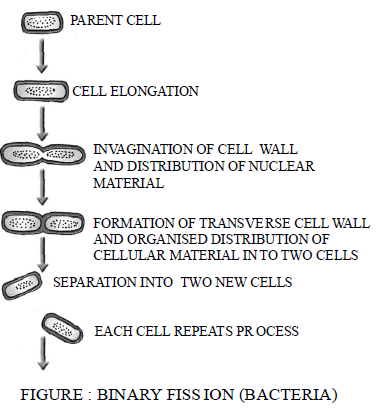
Multiple fission: Sometimes the nucleus divides into many daughter nuclei. The daughter nuclei arrange at the periphery of the parent cell, and a bit of cytoplasm around each daughter nuclei is present. Nucleus develops an outer membrane. Finally, the multinucleated body divides into many daughter cells. e.g. Blue green algae.
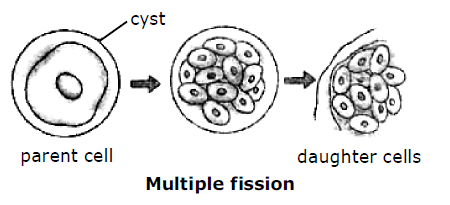
(2) Budding : In this type of reproduction, a small outgrowth appears on the body of the organism. This outgrowth is called a bud. The buds grow and finally detach from the parent body and begin to live as independent organisms.
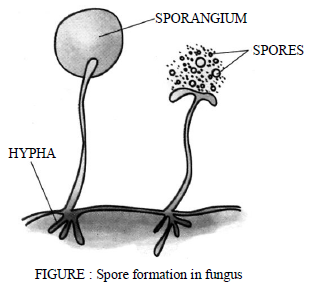
(3) Fragmentation : This takes place in algae like spirogyra and oscillatory. The filament of the alga breaks into two or more pieces called fragments, and the process is known as fragmentation. Each fragment the grows into a new plant.
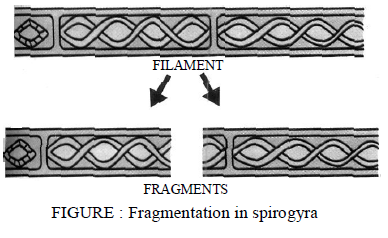
(4) Spore formation : Some lower plants such as ferns, mosses, lichens and fungi reproduce through spore formation under unfavourable conditions. Spores are tiny, microscopic bodies, which are covered by hard protective coats. The protective coats enable them to tide over adverse environmental conditions. When favourable conditions return, each spore gives rise to a new individual.
ASEXUAL REPRODUCTION IN PLANTS
When reproduction takes place only from the vegetative parts of plant known as vegetative reproduction.
(a) Natural vegetative propagation.
(b) Artificial vegetative propagation.
→ Natural vegetative propagation :
- Natural propagation by leaf : Vegetative propagation by leaves can be seen in very few plants like bryophyllum and begonia. In these plants buds are produced on leaf margins. These buds after falling on the ground grow into new plants.
- Natural propagation by stem : Underground stems are modified for storage of food. ?These
underground stems produce several new plants from their buds. Modified stems like tuber, bulb, rhizome and corm help the plants to multiply.
- Natural propagation by root : Roots also help in vegetative propagation. For example, sweet
potato and dahlia give rise to new plants from their fleshy roots. (figure)
→ Artificial vegetative propagation :
- Grafting : In this commonly practiced method a new variety is obtained from the mother plant (figure). In this process a detached part of one plant is inserted into the stem or the root system of another plant.
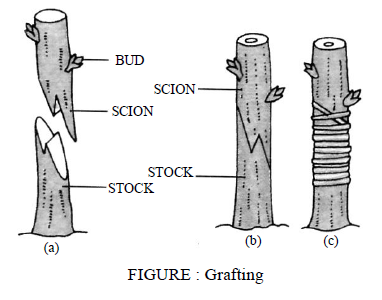
The short piece of detached shoot containing several buds is called scion. The lower portion of the plant that is fixed to the soil by its roots system is called the stock. They establish vascular connection with each other after a few days.
- Layering : In this method a young branch is bent towards the ground and covered with moist soil. After some days, new roots develop from the covered part, which is in contact with the soil. This is called a layer and the process is called layering. The branch is then separated from the parent plant and allowed to grow into a new independent plant.
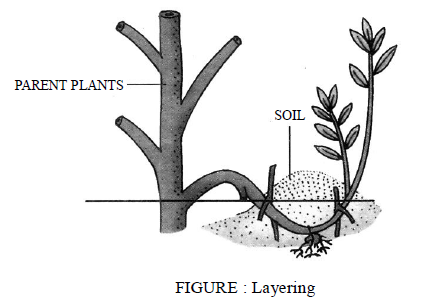
- Cutting : In this method a healthy young branch of a plant having leaf buds is cut out and planted in moist soil (figure). The branch develops root and grows into a new plant. Bougainvillea, sugarcane, rose and grapes are grown from cuttings.
SEXUAL REPRODUCTION IN PLANTS
Flower is a reproductive part of plant. Which contain male & female sex organ & produce ovum & pollen grain. A normal flower consists of four whorls namely sepals, petals, androecium and gynoecium (figure).
The androecium is the male reproductive part of the flower. Androecium may consist of one or more tube-like stamens. Each stamen consists of thin stalk called filament and a two-lobed head called the anther. Anther contains pollen grains which produce male gametes. The pistil or gynoecium is the female reproductive part of the flower. Each pistil consist of stigma, style, and ovary. The ovary contains one or more ovules.
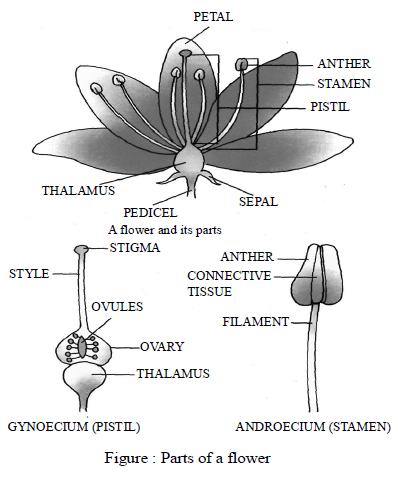
POLLINATION
Pollination is the process by which pollen grains from the anther of a flower are transferred to the stigma of the same flower or another flower.
- Types of pollination :
There are two types of pollination which are described below :
- Self-Pollination or Autogamy :
It is the process of transfer of pollen from anther to the stigma of the same flower or to the stigma of another flower of the same plant.
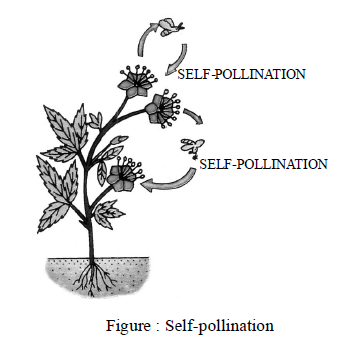
- Cross-pollination or Allogamy :
It is the process of transfer of pollen from the anther of a flower to the stigma of a flower of another plant of the same species or sometimes of very closely related species.
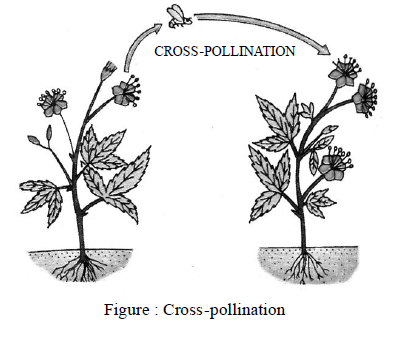
FERTILISATION
After successful pollination the stigma secretes nutrients for the lodged pollen grains. The pollen grains absorb these nutrients and grow to form a thin tube called pollen tube. This grows into the stigma in down the style (figure). It grows until it reaches the ovule and enters inside it. The pollen tube contains two male gametes. After reaching the ovule, it releases the male gametes, one of which fused with the egg to form the zygote. This process of fusion of a male gamete with a female gamete is called fertilization. The zygote develops into an embryo.
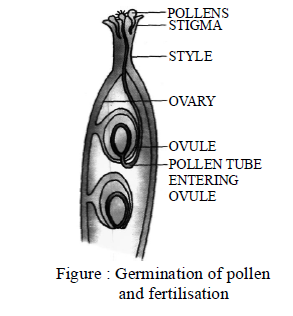
FRUIT & SEED FORMATION
After fertilization the ovary grows into a fruit and the ovules inside it become seeds. The other parts of the flower such as sepals, petals, and stamens fall off. A fruit is actually a biologically ripened ovary.
CBSE Class 7 Science Chapter 12 Reproduction in Plants Notes
We hope you liked the above notes for topic Chapter 12 Reproduction in Plants which has been designed as per the latest syllabus for Class 7 Science released by CBSE. Students of Class 7 should download and practice the above notes for Class 7 Science regularly. All revision notes have been designed for Science by referring to the most important topics which the students should learn to get better marks in examinations. Our team of expert teachers have referred to the NCERT book for Class 7 Science to design the Science Class 7 notes. After reading the notes which have been developed as per the latest books also refer to the NCERT solutions for Class 7 Science provided by our teachers. We have also provided a lot of MCQ questions for Class 7 Science in the notes so that you can learn the concepts and also solve questions relating to the topics. We have also provided a lot of Worksheets for Class 7 Science which you can use to further make yourself stronger in Science.
You can download notes for Class 7 Science Chapter 12 Reproduction in Plants for latest academic session from StudiesToday.com
Yes, the notes issued for Class 7 Science Chapter 12 Reproduction in Plants have been made available here for latest CBSE session
There is no charge for the notes for CBSE Class 7 Science Chapter 12 Reproduction in Plants, you can download everything free of charge
www.studiestoday.com is the best website from which you can download latest notes for Chapter 12 Reproduction in Plants Science Class 7
Come to StudiesToday.com to get best quality topic wise notes for Class 7 Science Chapter 12 Reproduction in Plants

